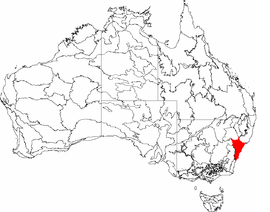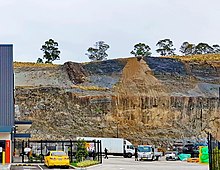Sydney Basin
| Sydney Basin New South Wales | |||||||||||||||
|---|---|---|---|---|---|---|---|---|---|---|---|---|---|---|---|
 Map of the Sydney Basin | |||||||||||||||
 The interim Australian bioregions, with the Sydney Basin in red | |||||||||||||||
| Coordinates | 33°56′53″S 150°45′36″E / 33.94806°S 150.76000°E | ||||||||||||||
| Population | 6,300,000[1] | ||||||||||||||
| • Density | 173.6/km2 (450/sq mi) | ||||||||||||||
| Area | 36,295.97 km2 (14,014.0 sq mi)[2] | ||||||||||||||
| |||||||||||||||
| |||||||||||||||
The Sydney Basin is an interim Australian bioregion and is both a structural entity and a depositional area, now preserved on the east coast of New South Wales, Australia and with some of its eastern side now subsided beneath the Tasman Sea. The basin is named for the city of Sydney, on which it is centred.
Around 5,000 metres (16,000 ft) thick, the Sydney Basin consists of
Sydney's famous
Geography
According to
The total area of the basin is approximately 44,000 square kilometres (17,000 sq mi) onshore plus 5,000 square kilometres (1,900 sq mi) offshore.[5] The centre of the basin is located around 30 kilometres (19 mi) west of the Sydney central business district at Fairfield, though only the youngest Triassic (middle Triassic) rocks are exposed in the Sydney area.[6]
The
History and formation
Minor igneous activity took place in the basin during the Early Jurassic (i.e. 210 million years ago), Late Mesozoic (i.e. 100-90 million years ago) and Cenozoic eras (i.e. 65 million years ago). The Early Jurassic activity resulted in the formation of the Prospect dolerite intrusion in Prospect Hill.[8] Although Jurassic sedimentation is not observed in the Sydney Basin, there are Jurassic volcanic breccia pipes (diatremes).[9]
The Sydney Basin is part of a major basin system that extends over 1,500 kilometres (930 mi) from the
Extension and breakup in the Tasman Sea beginning in the Late Cretaceous resulted in the current structural boundaries of the basin's eastern margin. In the south and west the Basin finishes in cliff lines formed on sandstones and conglomerates of the primary Permian sediments, with waterfalls being widespread on all escarpments.[2]
Timeline

- Permian: 299–252 million years ago; The settling and evolution of swamp forest, which would shape tremendous coal measures. To note, Australia's coal is younger than the Carboniferous coal of the Northern Hemisphere.
- Narrabeen shales can be viewed at Long Reef and Narrabeen. The Australian continent was part of the Gondwana supercontinent and the Sydney basin was situated within a depositional basin. The Ashfield Shale, which overlies the Sydney sandstone, indicates an alteration in river flow direction and its depositional style. That was when southeast-streaming rivers deposited fine grained sands and muds within a river delta which settled on a shallow sea's shore.[11]
- Mid Triassic: 247–235 million years ago; A monolithic river with its beginnings to the south-west of Plant fossilsare scarce, but some fish fossils are found in the clay lenses.
- seed fernfossils.
- End of Triassic: 201 million years ago; Ascension and shifting at the Lapstone fault, with the Blue Mountains rising and the Sydney CBDjousting upward.
- Jurassic: 201–145 million years ago; Erosion, with
- Cainozoic (Tertiary and Quaternary): 66 million years to present; Gondwana broke up around 40 to 60 million years ago. That is when the Australian continent started to form where it drifted and rifted, where Sydney's rocks were elevated, canted and then later eroded by the weather. Sydney's sedimentary rocks were shaped into a landscape that was defined by bedrock valleys exposed into a raised plateau. Sydney's largest rivers, such as the Hawkesbury, Parramatta, Georges and Hacking Rivers eroded the region's deepest valleys. In this period, the Ashfield Shale got weathered to create a flatter landform with low, undulating topography and reasonably fertile soils, which heavily contrasted the plateaus, cliffs and gorges on the sandstone areas in the Sydney Region.[11] The Botany BayBasin was also developed at that time, which is infilled with sand.
- Late Pleistocene: 12 000 years ago; Submerging the Sydney river valleys with the post-glacial sea level rise where estuaries and deep harbours were formed.[14]
Hydrology
The hydrology of the basin comprises three main drainage basins as defined by the New South Wales Office of Water that lie entirely or mainly within the geography of the basin; namely the Central Coast catchment, the Hawkesbury-Nepean catchment, and the Sydney Metropolitan catchment.
In addition, some of the rivers of the Hunter-Central Rivers catchment and the Southern Rivers catchment also lie mainly in the basin. In the Hunter-Central Rivers catchment, the Hunter River sub-catchment forms the northern boundary of the basin. In the Southern Rivers catchment, the Illawarra sub-catchment and the Shoalhaven sub-catchment forms the southern boundary.
See also
- Cumberland Plain
- Geography of Sydney
- Geology of Australia
- Illawarra Coal Measures
- Mittagong Formation
- Narrabeen group
- Sydney sandstone
- Wianamatta Shale
References
- ^ a b c "Sydney Basin bioregion". Bioregional assessments. Australian Government. 28 September 2016. Retrieved 25 March 2018.
- ^ a b c "Sydney Basin". Geoscience Australia. Australian Government. 2018. Retrieved 25 March 2018.
- ^ Herbert, C., 1983. Geology of the Sydney Basin 1: 100 000 sheet 9130. New South Wales Department of Mineral Resources, Sydney.
- ^ "Sydney Basin Structure Diagram". NSW Primary Industries. Retrieved 24 March 2008.
- ^ "Development of the Sydney Basin". NSW Primary Industries. Retrieved 24 March 2008.
- ^ "Sydney Basin – Geological Overview". Australian Museum. Retrieved 24 March 2008.
- ^ "Australia's bioregions (IBRA)". Department of Sustainability, Environment, Water, Population and Communities. Commonwealth of Australia. 2012. Retrieved 13 January 2013.
- ^ Jones, I., and Verdel, C. (2015). Basalt distribution and volume estimates of Cenozoic volcanism in the Bowen Basin region of eastern Australia: Implications for a waning mantle plume. Australian Journal of Earth Sciences, 62(2), 255–263.
- ISBN 978-0-521-38083-6.
- ^ Crawford, E. A., Herbert, C., Taylor, G., Helby, R., Morgan, R. & Ferguson, J., 1980 – 15. Diatremes of the Sydney Basin, p. 295-323., In Herbert, C. & Helby, R. (Editors.) – A Guide to the Sydney Basin. Geological Survey of New South Wales, Bulletin 26.20(1),25–33.
- ^ a b Geological History by Sydney Olympic Park.gov.au
- ^ Jones, I., Verdel, C., Crossingham, T., and Vasconcelos, P. (2017). Animated reconstructions of the Late Cretaceous to Cenozoic northward migration of Australia, and implications for the generation of east Australian mafic magmatism. Geosphere, 13(2), 460–481.
- ^ Wilshire: Wilshire, H.G., The Prospect alkaline diabase-picrite intrusion, New South Wales, Australia in Journal of Petrology, Vol. 8 (1), pp 97–163, 1967.
- ^ Branagan, D.F., and Packham, G.H., 2000. Field Geology of New South Wales. 3rd Edition. New South Wales Department of Mineral Resources, Sydney.
